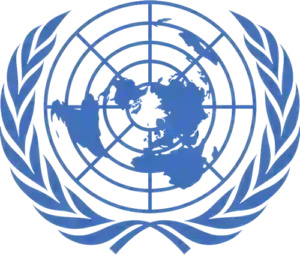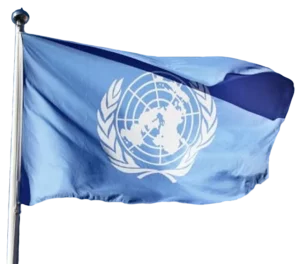The flag which so many Irish peacekeepers have proudly served under and the beret which they wore.
By George Kerton PRO IUNVA
In Apr 1945, near the end of World War II, fifty Allied nations gathered in San Francisco and this conference led to the establishment of the United Nations in Oct 1945. Delegates wore lapel buttons in a smoke blue colour with a map of the world centred on the North Pole with two olive branches surrounding the design. On 15 Oct 1946, during the first session of the United Nations General Assembly, Trygve Lie, the first United Nations Secretary General proposed that a seal or logo be used on all official documents and elsewhere.
San Francisco and this conference led to the establishment of the United Nations in Oct 1945. Delegates wore lapel buttons in a smoke blue colour with a map of the world centred on the North Pole with two olive branches surrounding the design. On 15 Oct 1946, during the first session of the United Nations General Assembly, Trygve Lie, the first United Nations Secretary General proposed that a seal or logo be used on all official documents and elsewhere.
The design team was led by Oliver Lincoln Lundquist, an American architect and industrial designer. The emblem was approved by General Assembly resolution 92 (I) on 7 Dec 1946. The design consisted of a blue background with the land areas and olive branches in gold and the water areas in white. Unofficially, this design was represented on a flag in white only, against a blue background with the words “United Nations” in English and French surrounding it. That flag was first displayed in 1947 by a UN commission working in Greece. Without its inscription, the same flag was officially adopted by the General Assembly on 20 Oct 1947 in Resolution 167(II) as a distinctive flag for the organisation.
 The UN Flag has the emblem in white in the centre set against a light blue background (colour code PMS 2925 in the Pantone Matching System). “UN blue” colour was selected because blue represents peace in opposition to red for war, the laurel leaves symbolise peace. The proportions of the flag are: Hoist (width) : Fly (length) 2:3 or 3:5 or the same proportions as the national flag of any country in which the UN flag is flown. The emblem is one half of the hoist and is entirely centred.
The UN Flag has the emblem in white in the centre set against a light blue background (colour code PMS 2925 in the Pantone Matching System). “UN blue” colour was selected because blue represents peace in opposition to red for war, the laurel leaves symbolise peace. The proportions of the flag are: Hoist (width) : Fly (length) 2:3 or 3:5 or the same proportions as the national flag of any country in which the UN flag is flown. The emblem is one half of the hoist and is entirely centred.
The UN emblem has been incorporated into the logo designs of several UN agencies and it is also used on UN stamps.
The UN Beret
The origins for the blue beret/cap/helmet go back to the first UN armed peace support operation in the Sinai Peninsula in 1956 when the United Nations Emergency Force (UNEF) was established. Up to then, there was no common dress or insignia. Canada provided a sizeable contingent to UNEF and they were uniformed the same as the British forces who were one of the belligerents in the conflict. To distinguish themselves as non-combatants, the Canadians painted their helmet liners light sky blue and their vehicles white, the same colours as the United Nations Flag. The peaked caps which were standard Canadian Army issue were dyed blue and issued to Canadian UN troops.
 Later, a common headdress was provided to peacekeepers and so the Blue Beret came to be the most recognised UN insignia.
Later, a common headdress was provided to peacekeepers and so the Blue Beret came to be the most recognised UN insignia.

